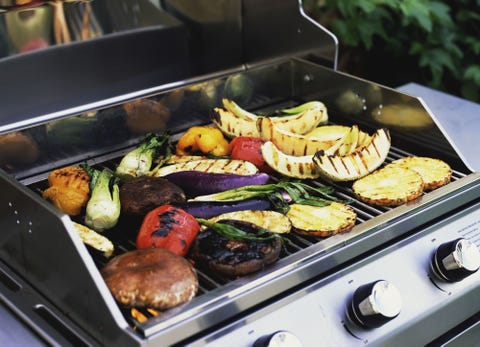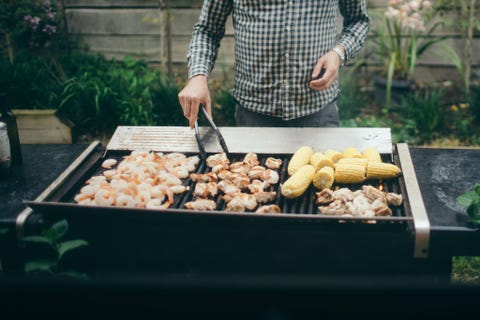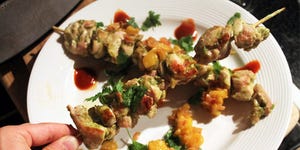
One of the best things about grilling is that you really have to try hard to screw things up. Unlike your finicky stovetop or your mysterious oven (what, really, goes on in there?), your grill is straightforward. Place food over flame. Let flame cook food. Eat delicious flame-cooked food.
Yes, you can carbonize a meal if you’re distracted. Yes, you can undercook meats that should not be undercooked (“Who would like their chicken medium-rare? Anyone?”) if you’re hurried. And, yes, you can singe your eyebrows if you’re too many beers deep to be operating anything involving a spark.
But beyond those risks, grilling is safe and easy. The techniques are simple, cleanup is basically non-existent, and grilled food tastes amazing.
If you’re new to all this, welcome to the fold. If you just need a refresher course, have at this one.
1. Choose a Grill
Grilling purists agree that charcoal provides the most flavorful meals, but the convenience and speed of gas grills has made them the most popular choice for home grills.

Sheri L GiblinGetty Images
Let’s tackle gas grills first. Unlike charcoal, gas grills require nothing beyond a 20-gallon propane tank and a button-press to start things heating. For some gas grills, you can even run a gas line into your home, bypassing the need for a tank. Gas grills are easier to clean (no leftover charcoal ash) and you can buy propane pretty much anywhere nowadays.
The big downside: Propane doesn’t lend grilled foods the flavor of charcoal. You can try to replicate the smokiness of charcoal by grilling with wood planks or wood chip packets, but that requires extra prep and cleanup—things you might not mess with if you’re looking for convenience and speed.
Charcoal grills deliver flavor cooking session after cooking session. Sure, you have to light the charcoal before you cook, but with a chimney starter that’s nearly as easy as starting a gas grill. Using a charcoal grill is convenient and speedy too.
And charcoal itself has come a long way since the chemical-clogged briquette days. Bags of hardwood charcoal, which burns fast and clean, are now nearly as available as propane tanks. This less adulterated charcoal still produces ash, and ash requires more cleaning than that involved with a gas grill, but it’s a small sacrifice to make for the amazing flavors produced by charcoal cooking.
(If you really want to get into this whole debate, you can dive deeper down the rabbit hole, but you still have grilling to get to.)
We’ve done the homework for you and selected the best grills and smokers we could find. Don’t forget your grilling accessories as well, including a digital meat thermometer which is one of the best investments you can make. It removes the guessing game of whether meat is done, and meals are never undercooked.

Getty Images
Beef
Steak, hamburgers, and hot dogs are the most popular foods to grill, and, unless it’s a massive cut like brisket, beef products should be cooked over direct heat and with the grill on the high setting (or with your coals a blazing white-hot). Turn the heat down slightly for hot dogs and thin-cut steaks to avoid blackening them.
Steaks and burgers cooked to medium are typically finished in less than 10 minutes. Steak in particular needs time to “rest” after you’ve removed it from the grill, so let it sit covered in foil for about five minutes before cutting into it. Resting helps the moisture within meat redistribute, resulting is juicer bites.
For more evenly-cooked, tender, and flavorful steaks off the grill, try scoring your meat. Using the tip of a sharp knife, first make shallow (about 1/8 inch deep) cuts across the grain one way, then the other way (perpendicular to first set of cuts). Repeat on the other side. Season the steak, then grill it on medium-high for a minute or two less per side.
Chicken
Grilling chicken requires a bit more patience than beef. Chicken can easily dry out on a grill, so you want to adapt your approach according to the type of poultry cut you’re cooking.
People love grilled chicken breast, but it’s actually one of the most difficult cuts of chicken for beginners to grill well. That’s because it has so little fat, which helps moisten and protect the protein as it cooks.
You have two ways to address this. One, you can brine the bird overnight. Basically, to brine, you stir up a simple salt-water solution, submerge the meat in said solution overnight (the protein takes in water with the salt), and then cook the brined chicken breast the next day. Two, you can buy skin-on chicken breasts. These also usually come with the bones attached, but that doesn’t matter. Just eat the meat off the bone with a fork and knife.
Medium to medium-high indirect heat works best for chicken breasts. Usually they’ll take at least 30 minutes to reach the required doneness of 165°F. Always use your meat thermometer to determine when the chicken is ready.
For chicken thighs, use the same approach, but worry less about brining. Their higher fat content helps prevent dry-out and carries flavor. They’re better suited for a marinate or baste.
For a whole chicken (you fancy now), that requires a bit more time and energy. This guide will help you navigate the involved, though delicious, grilled whole bird.
Pork
Grilling pork is similar to beef in that your more pre-portioned steaks and chops are best grilled over direct high heat, but your bigger roasts are better suited for indirect medium to medium-low conditions.

Ippei NaoiGetty Images
Pork chops can cook quickly and depending on the thickness only require 2 to 4 minutes per side before they’re done. (The USDA recommended internal temperature for pork is 145°F.)
Whole pork tenderloin, pork butt, pork shoulder, and other massive, meaty cuts of pork require indirect heat, medium to medium-low temperatures, and a lot more time and attention. If you’re adding wood smoke to all this, you’re barbecuing.
Seafood
This is a big category that includes fish, shellfish, cephalopods, and so much more deliciousness. Techniques differ depending on the exact type of seafood you’re cooking. However, in general…
…for fish
Use direct medium to medium-high heat and make sure that your grill grates and your fish are well oiled before grilling to help prevent the fish from sticking to the grill. You can also cook fish in a foil packet to avoid the mess. Fish is done when it is flaky.
…for shellfish
Use direct medium to medium-heat heat. Shrimp should be cooked shell-on to help prevent dry-out. (Peel and eat them at the table for a fun meal.) Lobsters are best split and cooked still in their shell. Clams and mussels can go directly on the grill grates and are done when they open.
…for cephalopods (squid, octopus)
Use direct high heat. If it’s squid, they’ll cook quickly so keep an eye on them. When they’re opaque, pull them. For octopus, if it’s par-boiled, just singe those suckers on all sides till they pickup a little char. Look at you, grilling octopus.
Vegetables
With a gas grill you can grill asparagus, eggplant, and zucchini, right next to your steak or chicken, just make sure you have the heat set to medium and be prepared to quickly remove your veggies as they can overcook quickly.
Corn is great on the grill but be patient as it can take about 30 minutes for corn in husk to cook on the grill.
4. Cleanup
Proper cleanup is the key to your next successful grilling session. Use a wire brush immediately after cooking to remove excess oil and food particles. Keeping the grill grates clean prevents the buildup of bacteria, discourages bugs and pests from trying to check out your grill, and prevents carbon buildup which can eventually alter the performance of your grill.
Use a grill cover when not in use, which will protect it from the elements and prolong it’s life.



From: Popular Mechanics
Source: Read Full Article